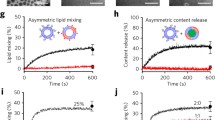Abstract
The fusion of HIV-1 with the plasma membrane of CD4+ cells is triggered by the interaction of HIV-1 surface envelope glycoprotein gp120 with the CD4 receptor, and requires coreceptors (CCR5 and CXCR4). Recent advances in the study of HIV-1 entry into CD4+ cells suggest that glycosphingolipids (GSL) may also participate in the fusion process. GSL are organized in functional microdomains which are associated with specific membrane proteins such as CD4. GSL-enriched microdomains were purified from human lymphocytes and reconstituted as a monomolecular film at the air–water interface of a Langmuir film balance. Surface pressure measurements allowed to characterize the sequential interaction of GSL with CD4 and with gp120. Using this approach, we identified globotriaosylceramide (Gb3) and ganglioside GM3 as the main lymphocyte GSL recognized by gp120. In both cases, the interaction was saturable and dramatically increased by CD4. We propose that GSL microdomains behave as moving platforms allowing the recruitment of HIV-1 coreceptors after the initial interaction between the viral particle and CD4. According to this model, the GSL microdomain may : i) stabilize the attachment of the virus with the cell surface through multiple low affinity interactions between the V3 domain of gp120 and the carbohydrate moiety of GSL, and ii) convey the virus to an appropriate coreceptor by moving freely in the outer leaflet of the plasma membrane. This model can be extrapolated to all envelope viruses (e.g. influenza virus) that use cell surface GSL of the host cells as receptors or coreceptors.
Similar content being viewed by others
References
Binley J, Moore JP, Nature 387, 346–8 (1997).
Clapham PR, Weiss RA, Nature 388, 230–1 (1997).
Weissenhorn W, Dessen A, Calder LJ, Harrison SC, Skehel JJ, Wiley DC, Mol Membrane Biol 16, 3–9 (1999).
Haywood AM, J Virol 68, 1–5 (1994).
Hakomori SI, Igarashi Y, J Biochem 118, 1091–103 (1995).
Simons K, Ikonen E, Nature 387, 569–72 (1997).
Brown RE, J Cell Sci 111, 1–9 (1998).
Fantini J, Tamalet C, Hammache D, Tourrès C, Duclos N, Yahi N, J Acquir Immune Defic Syndr Hum Retrovirol 19, 221–9 (1998).
Brown RE, Rose J, Cell 68, 533–44 (1992).
Sorice M, Parolini I, Sansolini T, Garofalo T, Dolo V, Sargiacomo M, Tai T, Peschle C, Torrisi MR, Pavan A, J Lipid Res 38, 969–80 (1997).
Millan J, Cerny J, Horejsi V, Alonso MA, Tissue Antigens 53, 33–40 (1999).
Hammache D, Yahi N, Piéroni G, Ariasi F, Tamalet C, Fantini J, Biochem Biophys Res Commun 246, 117–22 (1998).
Maggio B, Prog Biophys Mol Biol 62, 55–117 (1994).
Hammache D, Yahi N, Maresca M, Piéroni G, Fantini J, J Virol 73, 5244–8 (1999).
Delézay O, Hammache D, Fantini J, Yahi N, Biochemistry 35, 15663–71 (1996).
Hammache D, Piéroni G, Yahi N, Delézay O, Koch N, Lafont H, Tamalet C, Fantini J, J Biol Chem 273, 5967–71 (1998).
Tamma SL, Sundaram SK, Lev M, Coico RF, Biochem Biophys Res Commun 220, 916–21 (1996).
Puri A, Hug P, Munoz-Barroso I, Blumenthal R, Biochem Biophys Res Commun 242, 219–25 (1998).
Puri A, Hug P, Jernigan K, Barchi J, Kim HY, Hamilton J, Wiles J, Murray GJ, Brady RO, Blumenthal R, Proc Natl Acad Sci USA 95, 14435–40 (1998).
Puri A, Hug P, Jernigan K, Rose P, Blumenthal R, Biosci Rep 19, 317–25 (1999).
Fantini J, Hammache D, Delézay O, Yahi N, André-Barrès C, Rico-Lattes I, Lattes A, J Biol Chem 272, 7245–52 (1997).
Fantini J, Meth Enzymol 311, 627–38 (2000).
Lapham CK, Ouyang J, Chandrasekhar B, Nguyen NY, Dimitrov DS, Golding H, Science 274, 602–5 (1996).
Xiao X, Wu L, Stantchev TS, Fang YR, Ugolini S, Chen H, Shen Z, Riley JL, Broder CC, Sattentau QJ, Dimitrov DS, Proc Natl Acad Sci USA 96, 7496–501 (1999).
Haywood AM, Boyer BP, Biochemistry 21, 6041–6 (1982).
Long D, Berson JF, Cook DG, Doms RW, J Virol 68, 5890–8 (1994).
Fantini J, Hammache D, Delézay O, Piéroni G, Tamalet C, Yahi N, Virology 246, 211–20 (1998).
Haywood AM, In Cell Model Membrane Interactions (Ohki S, ed.) Plenum Press, NY, (1991), pp. 149–62
Author information
Authors and Affiliations
Rights and permissions
About this article
Cite this article
Fantini, J., Hammache, D., Piéroni, G. et al. Role of glycosphingolipid microdomains in CD4-dependent HIV-1 fusion. Glycoconj J 17, 199–204 (2000). https://doi.org/10.1023/A:1026537122903
Issue Date:
DOI: https://doi.org/10.1023/A:1026537122903




